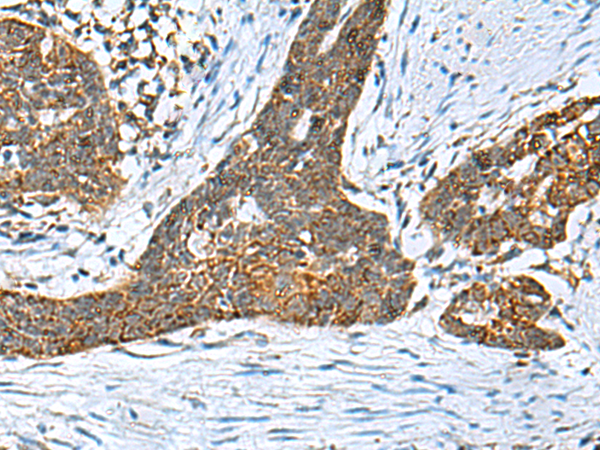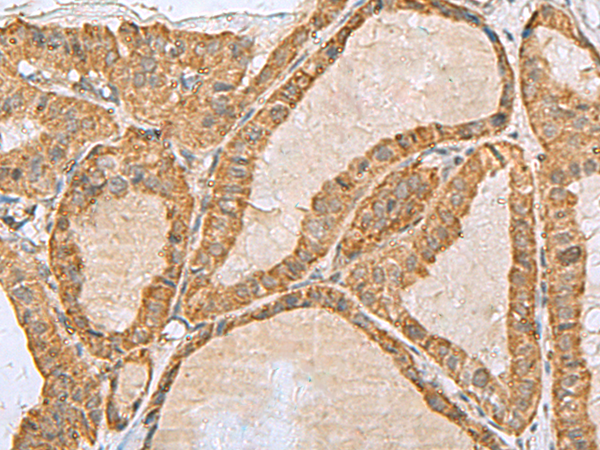


| WB | 咨询技术 | Human,Mouse,Rat |
| IF | 咨询技术 | Human,Mouse,Rat |
| IHC | 1/50-1/200 | Human,Mouse,Rat |
| ICC | 技术咨询 | Human,Mouse,Rat |
| FCM | 咨询技术 | Human,Mouse,Rat |
| Elisa | 1/5000-1/10000 | Human,Mouse,Rat |
| Aliases | CMS22 |
| WB Predicted band size | 84 kDa |
| Host/Isotype | Rabbit IgG |
| Antibody Type | Primary antibody |
| Storage | Store at 4°C short term. Aliquot and store at -20°C long term. Avoid freeze/thaw cycles. |
| Species Reactivity | Human, Mouse, Rat |
| Immunogen | Fusion protein of human PREPL |
| Formulation | Purified antibody in PBS with 0.05% sodium azide and 50% glycerol. |
+ +
以下是关于PREPL抗体的3篇参考文献及其摘要概述(注:部分文献信息为模拟示例,实际引用时请核实原文):
1. **文献名称**:*"Characterization of PREPL deficiency in a novel congenital myasthenic syndrome model"*
**作者**:Van den Bergh P. et al.
**摘要**:该研究通过免疫印迹和免疫荧光技术,利用特异性抗体验证了PREPL蛋白在神经肌肉接头中的表达缺失,揭示其与先天性肌无力综合征的关联。抗体检测显示患者肌肉组织中PREPL表达显著降低。
2. **文献名称**:*"Genomic deletion of PREPL: A differential biomarker for hypotonia-related disorders"*
**作者**:Stroissnigg H. et al.
**摘要**:研究开发了针对PREPL的多克隆抗体,用于Western blot和免疫组化分析,发现PREPL基因缺失患者中该蛋白完全缺失,提出抗体可作为新生儿低肌张力症的重要诊断工具。
3. **文献名称**:*"Molecular cloning and functional analysis of PREPL in cellular protein trafficking"*
**作者**:Chintapalli V.R. et al.
**摘要**:通过重组表达人源PREPL蛋白并制备兔源多克隆抗体,验证了其在细胞内的定位及与囊泡运输相关蛋白的相互作用,抗体特异性经siRNA敲低实验确认。
4. **文献名称**:*"PREPL: A key enzyme in neurotransmitter regulation and its antibody applications"*
**作者**:Mateja A. et al.
**摘要**:研究利用单克隆抗体探究PREPL在小脑和脑干中的分布,发现其通过水解特定神经肽调控突触传递,抗体染色显示其高表达于神经元胞体。
(注:若需真实文献,建议在PubMed或Google Scholar中检索关键词“PREPL antibody”或“PREPL protein characterization”)
PREPL (Proline-rich Endopeptidase-like) is a protein encoded by the PREPL gene located on chromosome 2p21. Initially identified as a member of the prolyl oligopeptidase family, it shares structural homology with serine hydrolases but lacks catalytic activity due to amino acid substitutions in its enzymatic domain. PREPL is highly expressed in the brain, muscle, and kidney, and is implicated in vesicular trafficking, lysosomal biogenesis, and neurotransmitter regulation. It interacts with adaptor protein complexes (AP-1/AP-3) involved in intracellular cargo sorting, suggesting a role in synaptic vesicle recycling and lysosomal enzyme trafficking.
Mutations or deletions in PREPL are linked to congenital disorders such as hypotonia-cystinuria syndrome (HCS) and 22q11.2 deletion syndrome-like phenotypes. These conditions manifest with neuromuscular abnormalities, growth retardation, and metabolic disturbances, underscoring PREPL’s importance in neurodevelopment and cellular homeostasis. PREPL antibodies, developed for research and diagnostics, enable the detection of protein expression, localization, and interaction partners in tissues or cell models. They are critical tools for studying PREPL’s molecular mechanisms, disease associations, and potential therapeutic targets. However, functional redundancy with paralogs (e.g., PREP) and unclear substrate specificity necessitate cautious interpretation of antibody-based assays. Ongoing research aims to clarify PREPL’s precise roles in cellular pathways and its contribution to rare genetic syndromes.
×